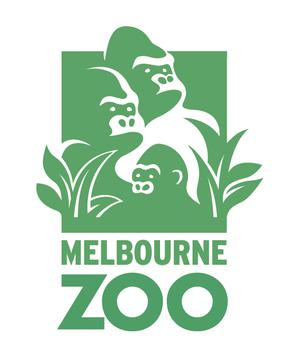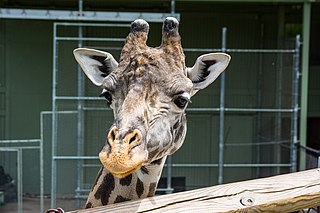
The San Diego Zoo is a zoo in Balboa Park, San Diego, California, housing 4,000 animals of more than 650 species and subspecies on 100 acres (40 ha) of Balboa Park leased from the City of San Diego. Its parent organization, San Diego Zoo Wildlife Alliance, is a private nonprofit conservation organization, and has one of the largest zoological membership associations in the world, with more than 250,000 member households and 130,000 child memberships, representing more than a half million people.

The Cheyenne Mountain Zoo is a zoological park located southwest of downtown Colorado Springs, Colorado, on Cheyenne Mountain in the United States. At an elevation of 6,714 feet (2,046 m) above sea level, it is the highest zoo in the country. The zoo covers 140 acres (57 ha), 40 of which are in use. The zoo houses more than 750 animals, representing nearly 170 different species, with more than 30 endangered species. The zoo was ranked the #4 best zoo in North America in 2018 by USA Today. It is accredited by the Association of Zoos and Aquariums.

Melbourne Zoo is a zoo in Melbourne, Australia. It is located within Royal Park in Parkville, approximately 4 kilometres (2.5 mi) north of the centre of Melbourne. It is the primary zoo serving Melbourne. As of 2021 the zoo contains 3742 animals comprising 243 species, from Australia and around the world. The zoo is accessible via Royal Park station on the Upfield railway line, and is also accessible via tram routes 58 and 19, as well as by bicycle on the Capital City Trail. Bicycles are not allowed inside the zoo itself.

The Los Angeles Zoo and Botanical Gardens is a 133-acre (54 ha) zoo founded in 1966 and located in Los Angeles, California, United States. The city of Los Angeles owns the zoo, its land and facilities, and the animals.

The Oklahoma City Zoo and Botanical Garden is a zoo and botanical garden located in Oklahoma City's Adventure District in northeast Oklahoma City, Oklahoma.

The Charles Paddock Zoo is a small 5-acre (2.0 ha) community zoo located in San Luis Obispo County, California, in the City of Atascadero, California. It is the only zoo in the Central Coast area of that U.S. state. It is home to an endangered male Malayan tiger named Menderu.

Happy Hollow Park & Zoo is a small 16-acre (6.5 ha) zoo and amusement park in San Jose, California, which originally opened in 1961. It was closed in 2008 for major renovations, and opened its gates again on March 20, 2010.

The Zoo Zürich is a zoo located in Zürich, Switzerland. It is considered one of the best zoos in Europe. Opened in 1929, it is the third oldest zoo in Switzerland and it accumulated a collection of 2,200 specimens of 300 species by its seventy-fifth year. It is located on Zürichbergstrasse, on the lower reaches of the Zürichberg in the Fluntern quarter.

The Little Rock Zoo was founded in 1926 and is located in Little Rock, Arkansas, United States. It is home to more than 725 animals representing over 200 species, and covers an area of 33 acres (13 ha). The Arkansas Zoological Foundation is a private 501 c (3) organization that raises funds for zoo development. The Little Rock Zoo is a department of the city of Little Rock. It is the largest zoo in Arkansas, and the only Arkansas zoo accredited by the Association of Zoos and Aquariums (AZA).

The Sedgwick County Zoo is an AZA-accredited wildlife park and major attraction in Wichita, Kansas, United States. Founded in 1971, with the help of the Sedgwick County Zoological Society, the zoo has quickly become recognized both nationally and internationally for its support of conservation programs and successful breeding of rare and endangered species. Having over 3,000 animals of nearly 400 species, the zoo has slowly increased its visitors and now ranks as the number one outdoor tourist attraction in the state.

Gladys Porter Zoo is a zoological and botanical park located in Brownsville, Texas, United States. The zoo officially opened on September 3, 1971, and currently averages over 424,000 visitors annually. Situated on 31 acres (13 ha), the zoo houses about 400 animal species and over 250 tropical and neo-tropical species and subspecies. It is the first zoo to have successfully bred the endangered Jentink's duiker. It is also the birthplace of Harambe, the gorilla.

The Santa Fe College Teaching Zoo is a 10-acre (4.0 ha) zoo in Gainesville, Florida. Located on Santa Fe College's main campus, it is the only college zookeeper training facility in the United States. Since 2000, the zoo has been accredited by the Association of Zoos and Aquariums (AZA).
The Fort Worth Zoo is a zoo in Fort Worth, Texas, United States, and is home to 7,000 native and exotic animals. It has been named as a top zoo in the nation by Family Life magazine, the Los Angeles Times and USA Today, as well as one of the top zoos in the South by Southern Living Reader's Choice Awards.

ABQ BioPark Zoo, located in Albuquerque, New Mexico, is a facility of the Albuquerque Biological Park. Founded in 1927, the 64-acre (26 ha) zoo was originally known as the Rio Grande Zoo. Sections of the zoo include an Africa exhibit area, an Australia exhibit area, the "Cat Walk" and a herpetology area. An endangered species carousel was added in 2016. A narrow-gauge railroad connects the zoo to the other facilities of the Albuquerque Biological Park. Walking distance through the zoo is 2.27 miles (3.65 km).
The Binder Park Zoo is a 433-acre (175 ha) zoo that opened in 1977 near Battle Creek, Michigan, in the United States. Binder Park Zoo is one of the largest zoos in Michigan, and features a large array of animals and plants, including the Wild Africa Exhibit. It includes a train, a tram, a carousel, and ropes course called "Skylark Ridge".

The St. Augustine Alligator Farm Zoological Park is one of Florida's oldest continuously running attractions, having opened on May 20, 1893. It has 24 species of crocodilians, and also a variety of other reptiles, mammals and birds, as well as exhibits, animal performances and educational demonstrations.

The American Species Survival Plan or SSP program was developed in 1981 by the (American) Association of Zoos and Aquariums to help ensure the survival of selected species in zoos and aquariums, most of which are threatened or endangered in the wild.

The San Antonio Zoo is an Association of Zoos and Aquariums-accredited zoo in Midtown San Antonio, Texas, United States. It is located in the city's Brackenridge Park. San Antonio Zoo is a 50+ acre zoo home to over 750 species, some of which are endangered or extinct in the wild, and an annual attendance of more than 1 million. It also runs non-animal attractions, such as the 2 ft narrow gauge San Antonio Zoo Eagle train ride, which first opened in 1956.

The Central Florida Zoo and Botanical Gardens is a 116-acre (47 ha) zoo and botanical garden located north of Orlando, Florida in Sanford. As a not-for-profit organization, it is a leader in conservation, providing experiences that inspire actions on behalf of wildlife. The Zoo has been an accredited member of the Association of Zoos and Aquariums (AZA) since 1986.

Barcelona Zoo is a zoo in the Parc de la Ciutadella in Barcelona, Catalonia, Spain. The zoo used to be internationally known as the home of Snowflake, the only known albino gorilla, who died in 2003.




































